A large stand of flowering ivy in the early autumn sunshine is an impressive sight. The many pale green globe flower heads give off their distinctive sickly-sweet smell and insects throng to the flowers to take advantage of the sudden abundance of pollen and nectar. Movement is constant and the entire bush buzzes audibly. Among the insects gorging themselves, there may be red admiral butterflies, plump stripy bumblebees, also good numbers of honeybees and wasps. Sometimes, especially near the sea in the south of the UK, these are outnumbered by beautiful honeybee-sized insects with a distinctive yellow and black banded abdomen and russet coloured thorax. These are ivy bees, the last of our solitary bees to emerge and it’s a delight to watch them each year in September and October.
Ivy bees are relative newcomers to the UK having arrived from mainland Europe eighteen years ago. Since then, they have prospered, spreading across the entire southern half of England and northwards as far as Cumbria As their name suggests, the species prefers pollen and nectar collected from flowering ivy and part of their success must reflect the large amounts of this climber that grow around the UK.
Each year I look out for the ivy bees; for me they signify the changing season, the movement of the year. September 2019 began very mild and dry where I live but, by the fourth week, temperatures dipped and intermittent wet and sometimes very wet weather set in and stayed with us during October and into November. In spite of the weather, I saw ivy bees in several places and here are some highlights of my 2019 observations:
A grassy bank in Sussex
In late September we spent a few days holiday in Sussex, a county in the south east of the UK. We had delivered our daughter to the University of Sussex to begin her degree and were keen to do some country walking. The weather was less than cooperative but on the 25th, our last day, we decided to walk up to the massive iron age hill fort at Cissbury Ring, high on the South Downs. We parked in the village of Findon not far from the 15th century pub, the Gun Inn, and as we passed the traditional butcher’s shop the butcher himself was standing outside wearing his blue and white striped apron.
We left the car and walked up through the village past some private houses where my attention was taken by movement in a grassy bank alongside one of the driveways. I was delighted to realise that this was a large colony of ivy bees. I hope the owner of the house is equally delighted, and I hope they know these are not wasps. Many male ivy bees were dancing about just above the surface of the grassy bank waiting for females to emerge. They occasionally coalesced into a mating cluster when a newly emerged female appeared and after a short time the cluster dissolved and the female and her chosen suitor were left alone. The incessant movement of the colony even on a dull day was very impressive. Here are two short videos which capture this movement.
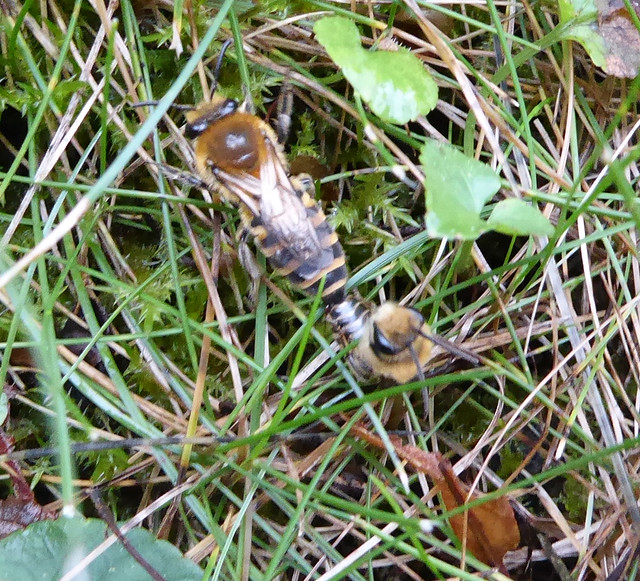
We left the ivy bees and continued uphill to reach Cissbury Ring. Today this was an elemental place: clouds scudded about driven by the strong blustery wind that was now also peppering us with raindrops and, when the clouds parted, the sun broke through leaving transient pools of light on the surrounding countryside. We kept to the eastern rampart to afford protection from the wind and from the highest point we saw the sea to the south and a second hill fort, Chanctonbury Ring to the north across rolling tea-coloured fields. A few hardy bees were braving the conditions to take advantage of the scattering of wild flowers across the chalk hillside.

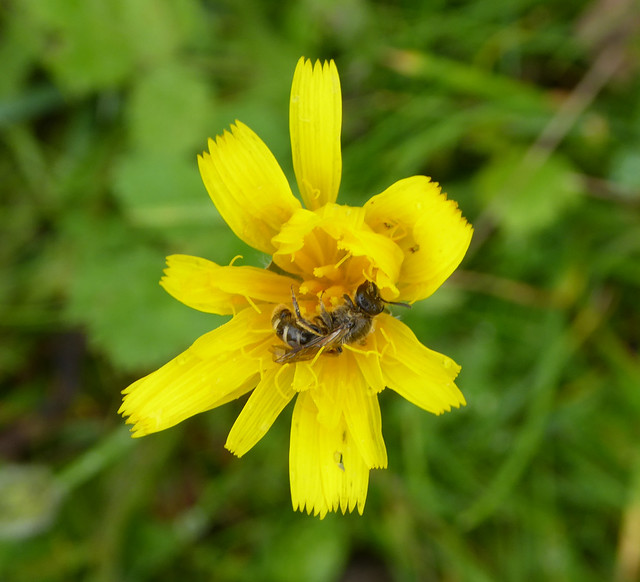
On our way back down the hill we passed banks of ivy in flower where, despite the intermittent drizzle, ivy bees were collecting nectar and pollen to take back to their nests.
Heath potter wasps, no – ivy bees, yes
Bovey Heathfield is a nature reserve, about half an hour’s drive from where I live with several claims to fame. It is a surviving scrap of lowland heath, a fragment of the large area of heathland that once covered this part of Devon. Even though it is small, the heath provides a unique environment with unique wildlife and in August and September it bursts into life as the heather blooms covering the land with a pinkish purple sheen. It’s also the site of one of the more important battles of the English Civil War, The Battle of Bovey Heath 1646 and on the reserve, there are memorials to the conflict.
I went to Bovey Heathfield on a windy Saturday afternoon (September 28th) under partly cloudy skies to meet John Walters, a local naturalist and wildlife expert. John knows more than anyone else about a species of solitary wasp that frequents sandy heaths. This is the heath potter wasp and the plan was for John to show me these insects. Unfortunately, the weather was not sunny enough to tempt the wasps out but he did show me one of the pots constructed from muddy clay by mated females that give them their name. They attach these pots to stalks of heather and gorse and then lay their eggs in the pot, equipping it with caterpillars as food before sealing. These are mini-marvels of engineering and John has some wonderful video showing the wasps constructing clay pots (see here).

In the absence of these insects, John showed me the large colony of ivy bees that has built nests in the south facing sandy paths on the heath. The ivy bees were not deterred by the cool conditions; the males were very active and a number of newly emerged females were mobbed by them. I saw one mating cluster develop around a female resting on a heather stalk and wondered how they all clung on.
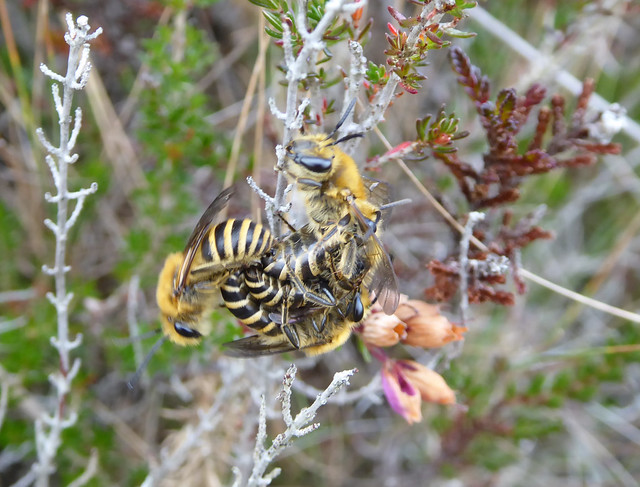
Ivy bees in a local cemetery

The river Dart drives a picturesque, watery wedge through the town of Totnes dividing it into two unequal parts. The eastern part, across the river, goes by the name of Bridgetown, a mixture of old and mostly new houses. Buried in the old part, behind the early nineteenth century St John’s Church is the cemetery. I rather like the cemetery, it is slightly unkempt with rough grass, trees, flowers and several large clumps of ivy. Most of the graves date from the 19th and 20th centuries and the place has a peaceful calm atmosphere. Last year I found ivy bees here for the first time, it was also the first time I had seen the species in Totnes. This year the ivy in the cemetery was late in flowering but finally on the last day of September some ivy bees appeared on a few of the open flowers. I saw males and pollen-carrying females, but not many of either gender. I wondered if they might be nesting in the cemetery but was unable to find any evidence. Somewhere nearby there must a nest aggregation.
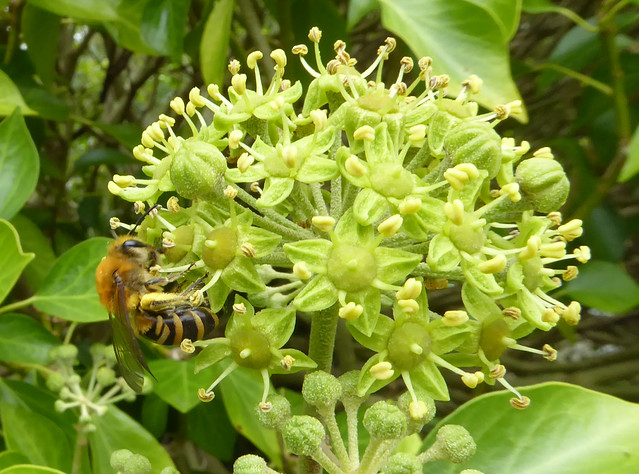
As I was poking about looking for ivy bee nests, one grave stone, for Edwin Jordain, caught my attention. It was late Victorian, dating from 1893 and had fine carvings of flowers along the top edge unlike most of the other graves. I wondered whether the flowers were symbolic or just decorative and did a little research.

The flowers on the left side are most likely blue passion flowers. I learnt that these were very popular adornments to Victorian graves, representing the suffering of Christ. I feel less comfortable about my identification of the flowers on the right but I think they are lilies, linked with purity and innocence by the Victorians, especially after death. Many of the flowers depicted are open, apparently symbolising the prime of life; Mr Jordain was only 36 when he died. His epitaph perhaps sums this up: “Brief life is here our portion”.
The picture at the head of the article shows a female ivy bee I saw at Paignton on October 8th. Here is a link to an article I wrote about the ivy bees at Paignton in south Devon that has recently been published on The Clearing: https://www.littletoller.co.uk/the-clearing/ivy-bees-by-philip-strange/
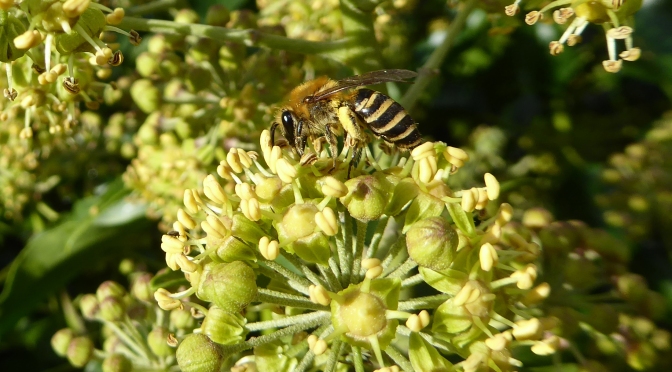

Your photographs and videos of the ivy bees are great. They are such beautiful bees and are even more special as they are around for such a short time. We have Potter wasps here but the pots are a little different so it is probably a slightly different species. I have never seen any of the pots on plants but now I think of it, window ledges and shutters cannot be their natural nesting place. Amelia
LikeLike
Thanks Amelia, ivy bees are very beautiful bees.
I have seen pictures of some of the pots.made by other potter wasps (in France) and they are quite different. The pictures I saw showed the wasps building their nests inside cupboards.or behind curtains or books.
LikeLike
Hello Philip,
Wonderful photos and details of ivy bees and the potters wasp – I’ve never heard of this insect before, and the videos are amazing – extraordinary how quickly these can construct and provision their nest. Thanks for this excellent post,
best wishes
Julian
LikeLike
Thanks, Julian, glad you liked the photos etc. The heath potter wasp is an amazing creature and I hope next season I shall see one in person!
LikeLike
I really enjoyed the photos, Philip. I know nothing of ivy bees, and I’m always so intrigued with the information you share, and of your knowledge! I don’t seem to have much of an eye to distinguish the different species, although I would imagine that in my garden I’m limited to one or two. Still, I learn so much from your wonderful explorations.
I love old cemeteries. I have never researched the ornamentations on the headstones, and I’m glad you did. It provided a very interesting commentary.
LikeLiked by 1 person
Thanks, Debra, if you have flowers in your garden then I would guess you would attract pollinators. In the case of my own garden, I was very surprised, once I started looking properly, at how many different species visit.
LikeLike
Thanks for the bee info. I marvel at the constant change that nature undergoes.
LikeLike
Thanks Frank, yes nature is always in a state of flux.
LikeLike
Great tour and photos/videos. Our bees and wasps are now all asleep or dead here so it’s nice to be able to see some flying around. It makes me look forward to next spring and reminds me I can just turn to blogs like yours and to YouTube when I need a hymenoptera fix.
LikeLike
Thanks for your comment. The ivy bees lasted until the beginning of November but I am lucky enough to live in a mild part of the UK so that if I need a hymenoptera fix I can see bumblebees throughout the winter
LikeLike
I didn’t know there were wasps that made nests from clay, what a clever idea.
LikeLike
Yes, I was also amazed when I first heard, they take a lot of effort to do it as well.
LikeLike